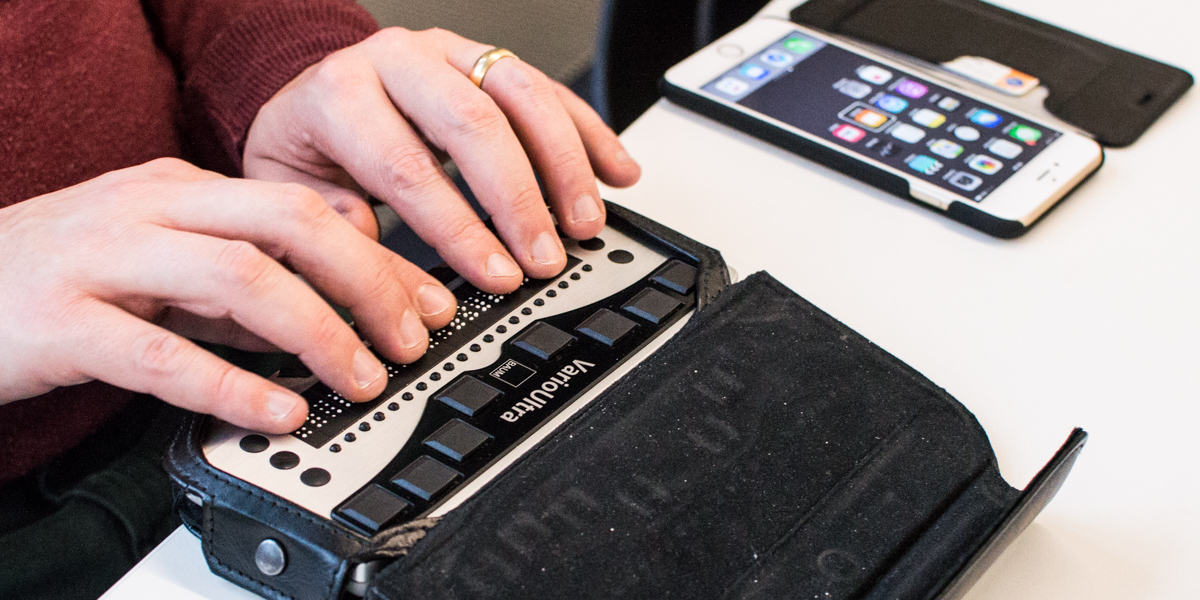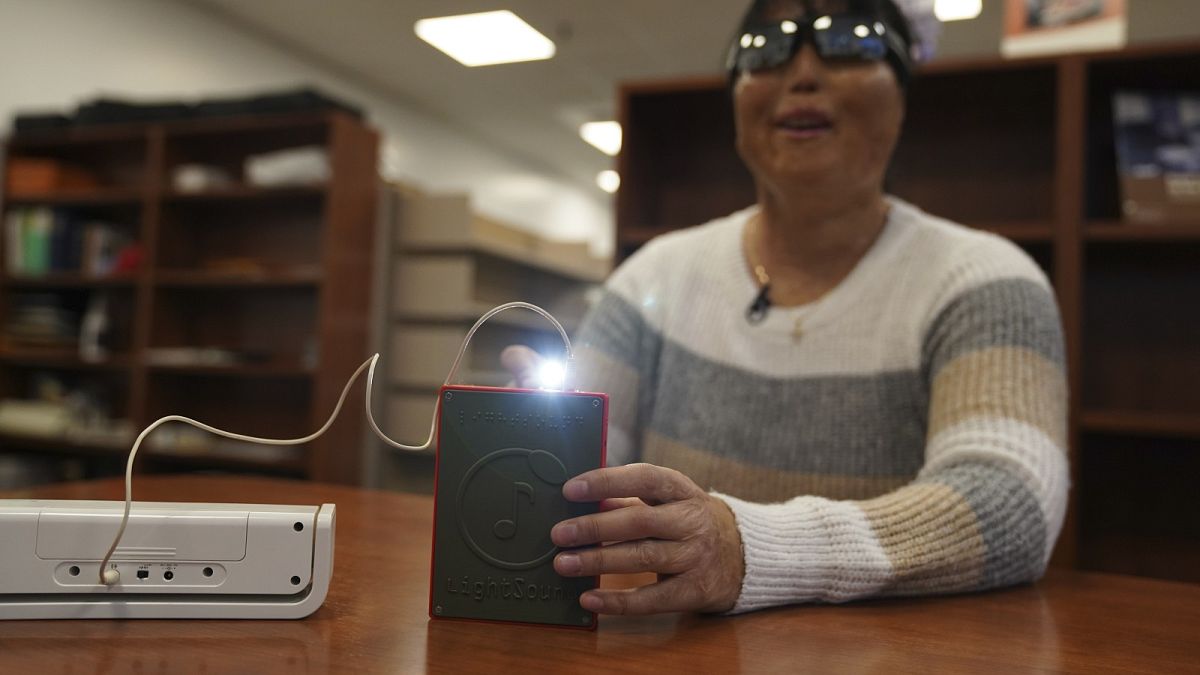Discover Cutting-edge Tools Made for the Aesthetically Damaged
The advancement of cutting-edge devices for the visually damaged stands for a substantial development in ease of access and self-reliance. Technologies such as smart glasses with AI capabilities and mobile applications created to supply auditory descriptions are improving everyday experiences for customers. Furthermore, wearable devices that employ haptic feedback improve environmental recognition, while modern Braille developments provide new ways to involve with message. As these tools continue to evolve, their influence on the lives of those with visual disabilities increases vital questions concerning the future of inclusivity and autonomy in various aspects of life. What exists ahead in this technological landscape?
Smart Glasses for Navigation

Smart glasses designed for navigation are reinventing the means aesthetically impaired people connect with their atmosphere. These advanced gadgets utilize a mix of camera modern technology, artificial intelligence, and acoustic responses to offer real-time information concerning surroundings. By employing barrier detection systems, smart glasses can notify individuals to possible hazards, making it possible for much safer movement in both acquainted and unknown settings.
The assimilation of GPS technology additionally boosts navigation capacities, permitting users to obtain acoustic directions as they move. This hands-free method not only fosters independence however likewise empowers aesthetically impaired people to navigate urban landscapes with raised self-confidence. Furthermore, lots of smart glasses are equipped with attributes that identify spots and road indications, providing contextual information that enhances the individual experience.
Additionally, the advancement of these devices is continually advancing, with business functioning to enhance the accuracy of item acknowledgment and increase the series of navigational functions. As clever glasses become more affordable and available, they hold the prospective to dramatically transform day-to-day live for aesthetically damaged individuals. Inevitably, these ingenious devices represent a critical action towards inclusivity, offering enhanced movement and a greater sense of freedom for people browsing the globe around them.

Mobile Apps for Daily Living
Just how can mobile applications improve the everyday lives of visually impaired individuals? Mobile applications are changing the means visually impaired users browse their atmospheres, handle daily jobs, and gain access to info. These applications provide vital assistance with different performances, promoting freedom and boosting high quality of life.
Several innovative mobile apps are created particularly for daily living. Apps like Be My Eyes connect visually damaged customers with sighted volunteers through video telephone calls, enabling them to obtain real-time support with tasks such as reading labels or navigating strange spaces. Likewise, Seeing AI, created by Microsoft, utilizes expert system to describe surroundings, read message, and recognize objects, properly transforming a smart device right into a powerful tool for daily assistance.
Furthermore, navigation applications tailored for the aesthetically damaged, such as Aira and BlindSquare, use audio-based directions and ecological info, making it possible for individuals to traverse their surroundings safely and confidently. Beyond navigation and instant help, mobile applications likewise sustain company and task monitoring, with features that aid customers set tips, develop order of business, and track visits. In recap, mobile applications function as essential resources, encouraging visually impaired people to lead even more independent and satisfying lives.
Wearable Technologies for Aid
Empowerment via modern technology is significantly evident in the world of wearable devices developed to help visually damaged individuals. These innovative devices integrate perfectly right into every day life, improving navigation and offering essential responses to customers. Smart glasses geared up with cameras can review and recognize faces text out loud, allowing users to connect even more confidently in specialist and social settings.
One more noteworthy advancement is making use of haptic comments systems in wearable gadgets. These systems make use of resonances or various other tactile signals to convey info about the customer's environment, such as challenges or adjustments in surface, boosting mobility and security. Wearable innovations also consist of wristbands that attach to smartphones, signaling users to notifications via subtle resonances, therefore boosting connectivity without dependence on visual cues.
As these innovations proceed to evolve, they are not just improving self-reliance for aesthetically damaged individuals but likewise fostering a better feeling of incorporation in society. By connecting the gap between obstacles faced in everyday living and the capacity for freedom, wearable modern technologies offer as critical tools in the quest for equal rights and empowerment for those with visual see this disabilities.
Audio Description Tools
Audio summary tools play a vital role in enhancing ease of access for aesthetically impaired people, giving them with the capacity to involve with visual media. Assistive technology for the blind. These devices provide narrated descriptions of vital aesthetic components in movies, television programs, and live performances, making certain that customers can fully understand the context and emotions shared via visuals
Sound description can be incorporated right into different platforms, consisting of streaming services, cinema testings, and live movie theater. Numerous popular streaming services now consist of audio summary as an accessibility attribute, enabling viewers to choose it easily. Along with traditional media, specialized apps also exist, supplying audio summaries for art exhibitions, museums, and various other cultural occasions.
The effectiveness of audio summary rests on the ability of the narrators, who need to convey visual details succinctly without diminishing the original sound. Technologies in this area are likewise leading the way for more customized experiences, where users can readjust the level of information and pacing according to their choices.
Braille Innovations and Devices
Braille tools and technologies have substantially transformed the method aesthetically impaired individuals connect with text and info. Modern innovations have actually led to the development of functional devices that boost proficiency and independence amongst users. Significantly, Braille display modern technologies have developed, enabling for dynamic additional info reading experiences. These gadgets convert electronic message right into Braille, making it possible for customers to access a substantial variety of info on tablet computers, computers, and mobile phones.
Moreover, mobile Braille notetakers incorporate typical Braille input with modern performances, promoting note-taking, scheduling, and record editing and enhancing on the go. Smart glasses for the visually impaired. These compact devices often feature text-to-speech capacities, linking the gap in between Braille and acoustic information
Additionally, innovative Braille printers have emerged, allowing individuals to generate Braille tags, papers, and educational materials effectively. This access fosters better participation in educational and professional environments, inevitably promoting inclusivity.
In addition, research study right into smart Braille technologies remains to increase. Devices that integrate expert system are being explored to supply real-time navigation aid and contextual info, enhancing the user experience in diverse setups. In general, these innovations show a dedication to equipping visually impaired people through innovation, ensuring they can quickly accessibility and engage with the globe around them.

Final Thought
The improvement of cutting-edge tools for the aesthetically impaired dramatically improves freedom and quality of life. These technologies not just foster higher inclusion however also promote freedom in everyday tasks, inevitably contributing to a much more available and equitable society for aesthetically impaired individuals.
As clever glasses come to be extra obtainable and budget-friendly, they hold the prospective to substantially change day-to-day life for aesthetically damaged users. Mobile apps are reinventing the way visually damaged users browse their settings, manage day-to-day jobs, and accessibility details. Apps like Be check here My Eyes attach visually impaired users with sighted volunteers via video clip telephone calls, permitting them to get real-time assistance with tasks such as reviewing tags or browsing unknown rooms.Additionally, navigation apps tailored for the aesthetically damaged, such as Aira and BlindSquare, provide audio-based directions and environmental info, allowing customers to traverse their environments safely and with confidence.The improvement of innovative devices for the visually damaged substantially boosts independence and high quality of life.